Gma's and Gpa's Great Adventures
Ka’oha!
We are in the Marquesa Islands, a group of 12 rugged volcanic islands (6 inhabited) forming the northern most part of French Polynesia. At about 8degrees S latitude the Marquesas (pronounced Marqueez) are a 214 mile chain of islands with steep mountains, lush valleys and dry canyons with only a few areas of sandy beaches or coral reefs. The most remote island group in the world, these islands are not for those looking for a luxurious beach resort vacation.
The first settlers came from Samoa around 150BC. At one time, before the Europeans came, there were approx. 100,000 Marquesans. About 10,000 people now inhabit the islands – along with feral horses, goats and pigs. The Marquesans have a rich heritage of art, especially stone sculpture, geometric stone, bone and wood carving, tattooing and tapas made from bark.
RUTH METZ
32 chapters
29 Jan 2023
The Marquesas
French Polynesia
Ka’oha!
We are in the Marquesa Islands, a group of 12 rugged volcanic islands (6 inhabited) forming the northern most part of French Polynesia. At about 8degrees S latitude the Marquesas (pronounced Marqueez) are a 214 mile chain of islands with steep mountains, lush valleys and dry canyons with only a few areas of sandy beaches or coral reefs. The most remote island group in the world, these islands are not for those looking for a luxurious beach resort vacation.
The first settlers came from Samoa around 150BC. At one time, before the Europeans came, there were approx. 100,000 Marquesans. About 10,000 people now inhabit the islands – along with feral horses, goats and pigs. The Marquesans have a rich heritage of art, especially stone sculpture, geometric stone, bone and wood carving, tattooing and tapas made from bark.


After 27 days and nights at sea, we finally arrive to NUKU HIVA, the main island of the Marquesas, just after sunset. We raise our yellow quarantine “Q” flag and anchor in Taiohae Bay, our port of entry. In the morning we dinghy in to get all checked in at Immigration. We quickly learn that early morning is the time to buy some local fish, produce and fresh-out-of-the-oven baguettes before they run out. Checking out Taiohae, we buy some provisions, find an ATM for CFP (French Pacific Franc, they don’t take US$), find a place for coffee/lunch and WIFI, order bread and croissants for tomorrow morning and arrange an island tour for tomorrow.
After our long voyage, we needed to replenish Nutmeg’s fuel (we hold 237 gallons of diesel + 60gal in jerry jugs). Being a small remote island you can’t just take Nutmeg up to the fuel dock and fill-er-up. You need to take the dinghy in with jerry jugs, fill them, bring them back to Nutmeg to then empty into the diesel tanks. They only allowed us to get 50 gallons.
The next day, after enjoying our morning coffee and croissants, Mate Excursions take us to see this amazing island (a 2002 “Survivor” site).

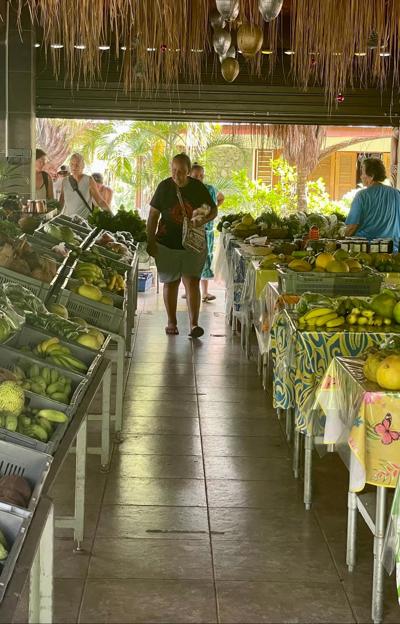

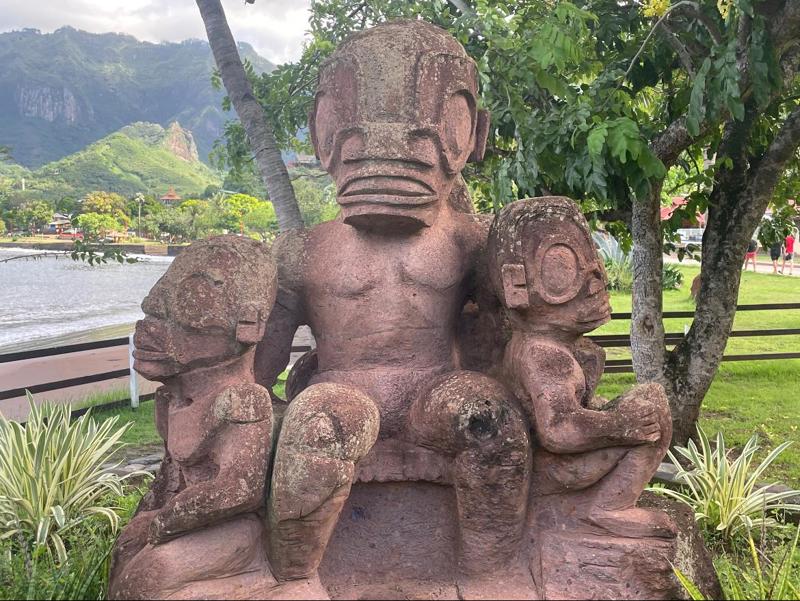
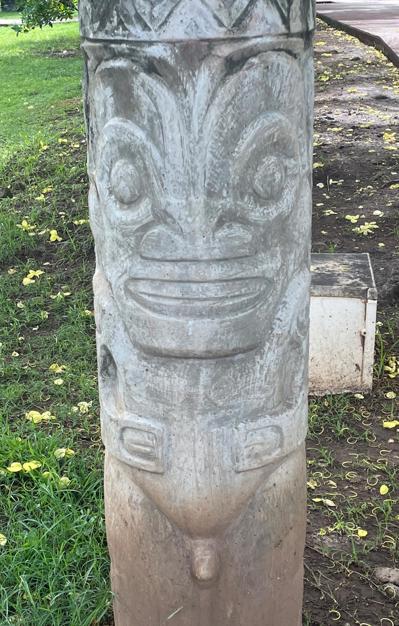

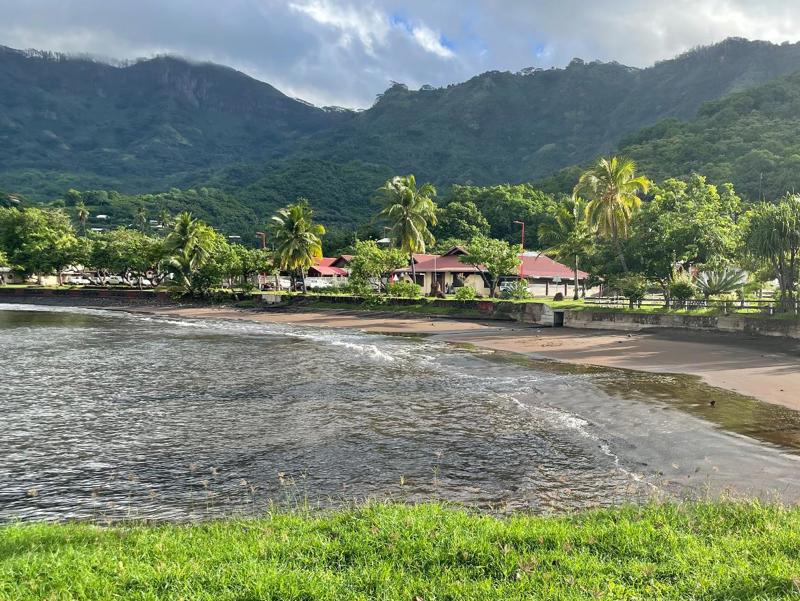
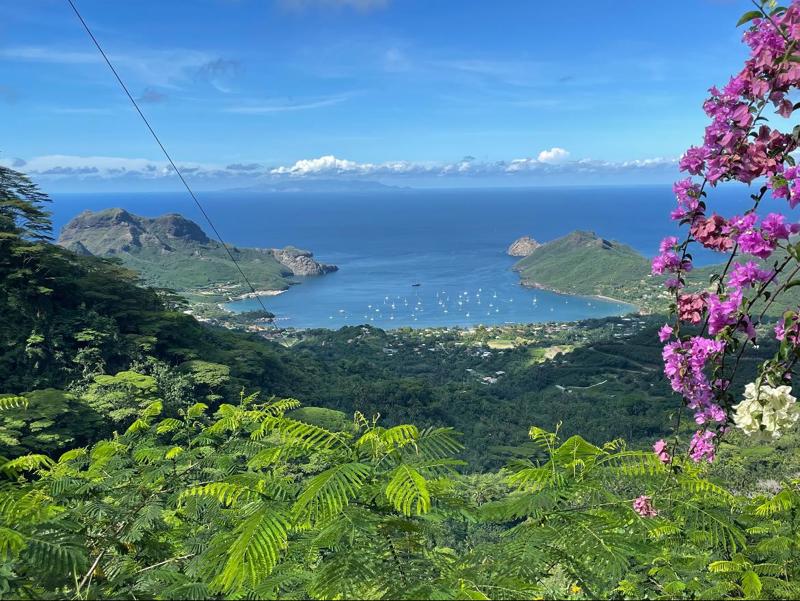
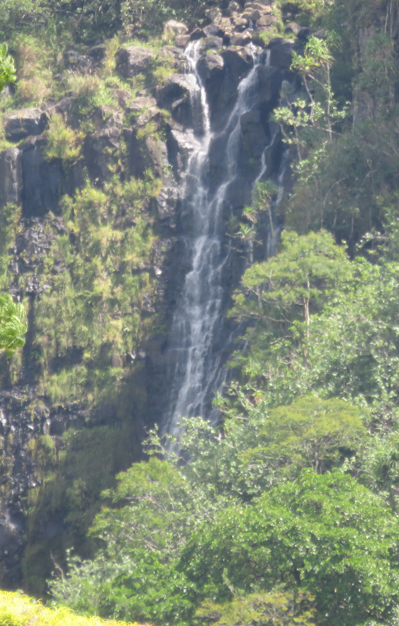
Most of its 127sq miles is straight up and down formed by two volcanoes and their eroded craters many many years ago. Besides all the breathtaking scenery of mountains, valleys, beaches, rock formations, vegetation, flowers, what really amazed me was how clean, natural and undeveloped the island still is. It seems like we are in a national park. I hope it can stay this way for future generations to enjoy. We stop at Kamuihei, a historic site once used for ceremonial dances and sacrifices with well-preserved tikis (carved stones), restored paepaes (stone foundations) and Me’aes (ceremonial platforms), petroglyphs carved into huge boulders, and an enormous banyan tree once used as a jail. We have a nice lunch at Chez Yvonne in Hatiheu, a picturesque shore village with a curving black sand beach and basaltic stovepipes. And we stop at Anaho’s palm-fringed white sand beach (also known for its no-no’s, biting sand flies).
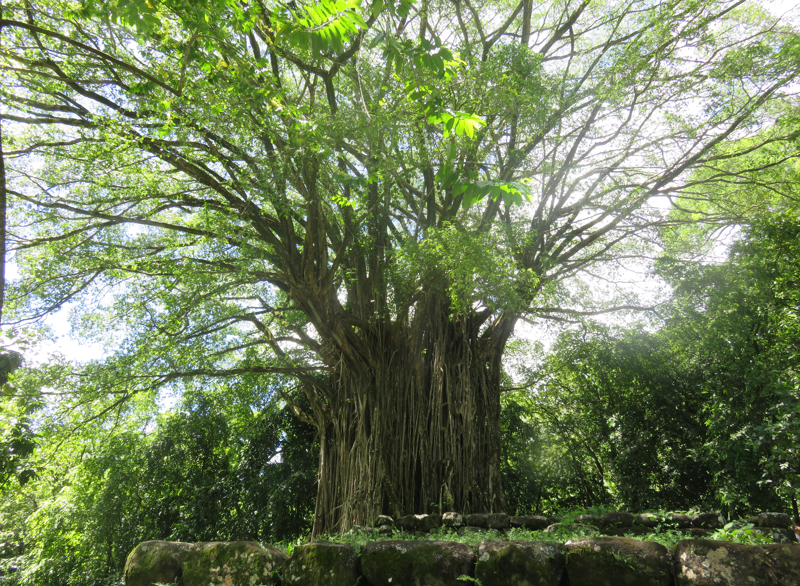
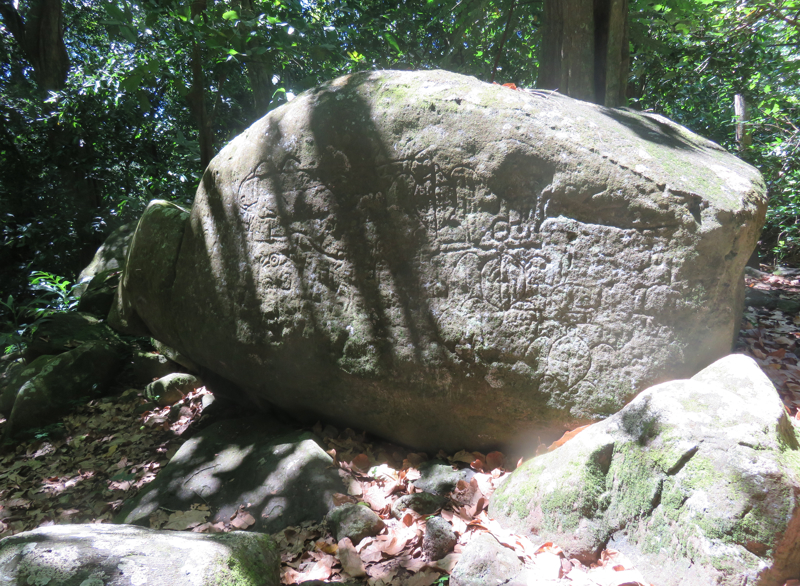

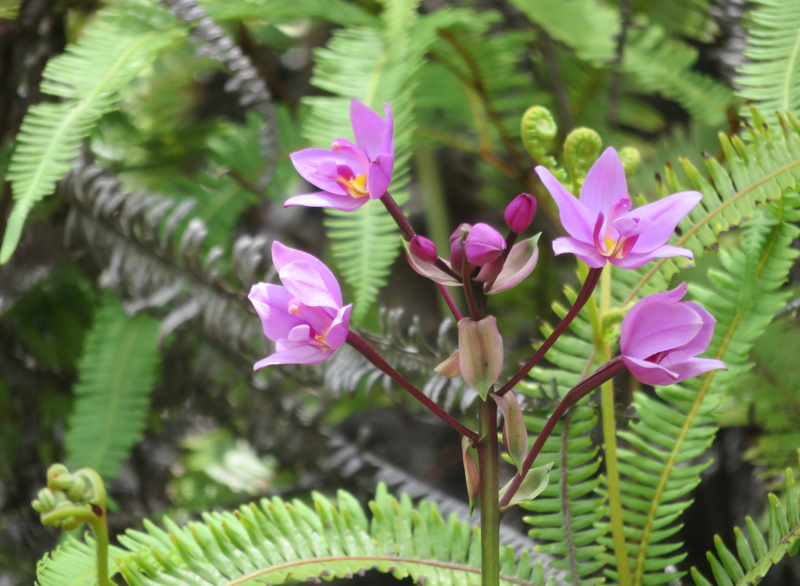


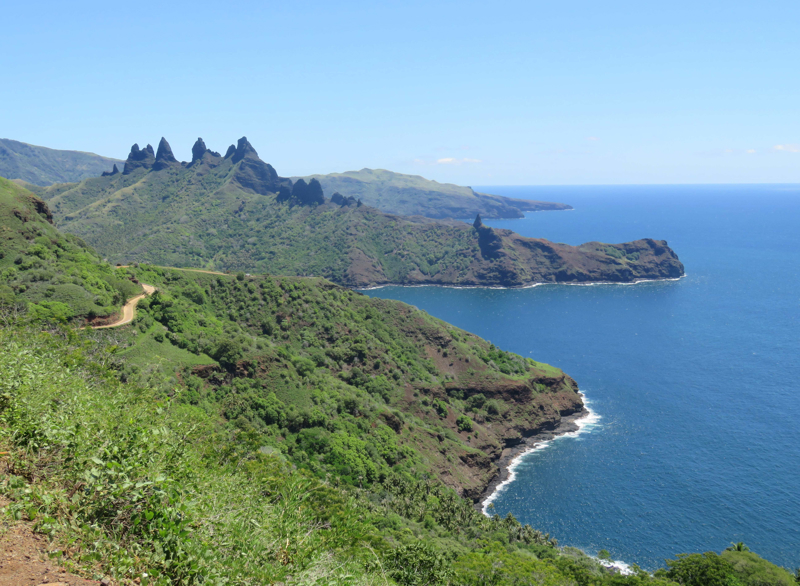
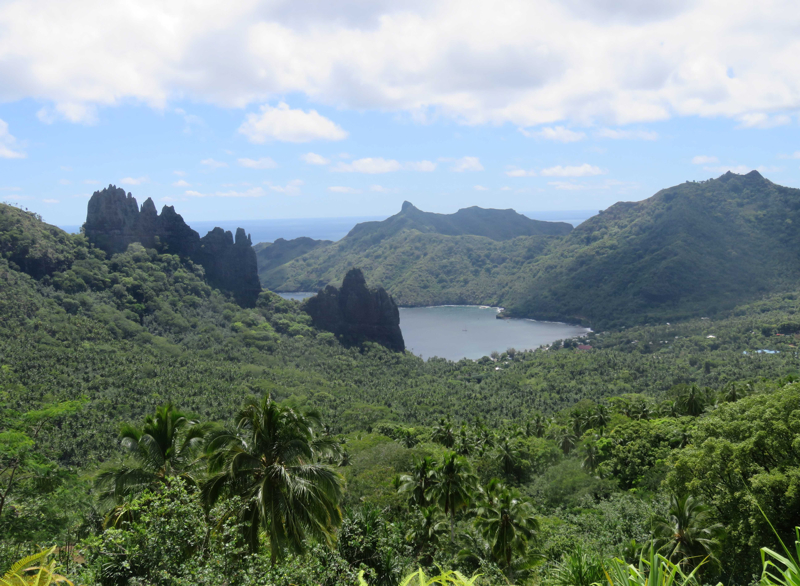
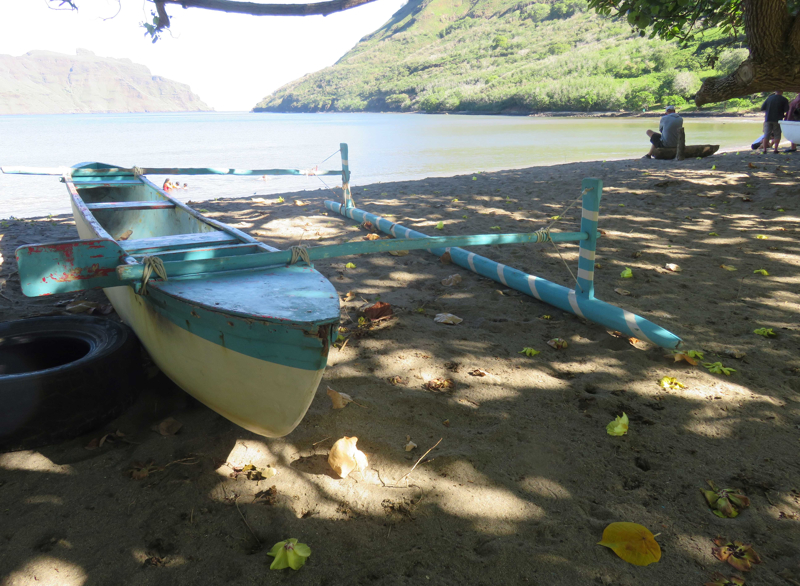
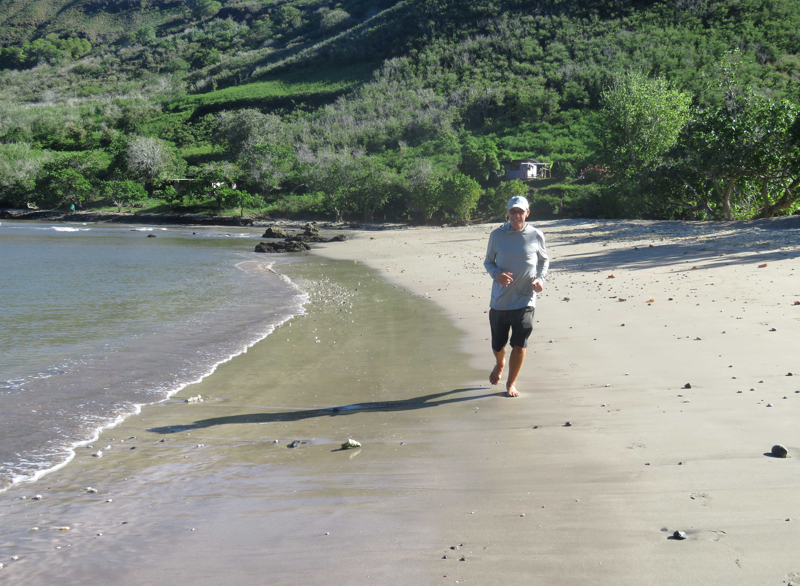


Time to move on for an overnight sail to TAHUATA, a small mountainous crescent shaped lightly populated island with a mostly rugged shoreline, near Hiva Oa. We anchor in a small sandy bay and discover a nice snorkel area with many fish I have never seen before. It’s been a long time since I’ve scuba’d so Whitey to us down off the back of the boat for a quick scuba refresher. After a couple nice quiet days and nights here we sail across to HIVA OA.
The largest island of the Marquesas, HIVA OA is also a Port of Entry for sailors, and is full of ARC and PPJ boats arriving from their Pacific passage. There is no room in the inner bay so we anchor with the other boats in the rougher outer bay. With all the swells, waves, tides, currents and boat traffic it is rollie, making getting on and off the dinghy more challenging and really rocks you to sleep (if you like that sort of thing). The dinghy dock leaves something to be desired, it’s rainy, the village (Atuona) is a long 45 minute uphill walk to get

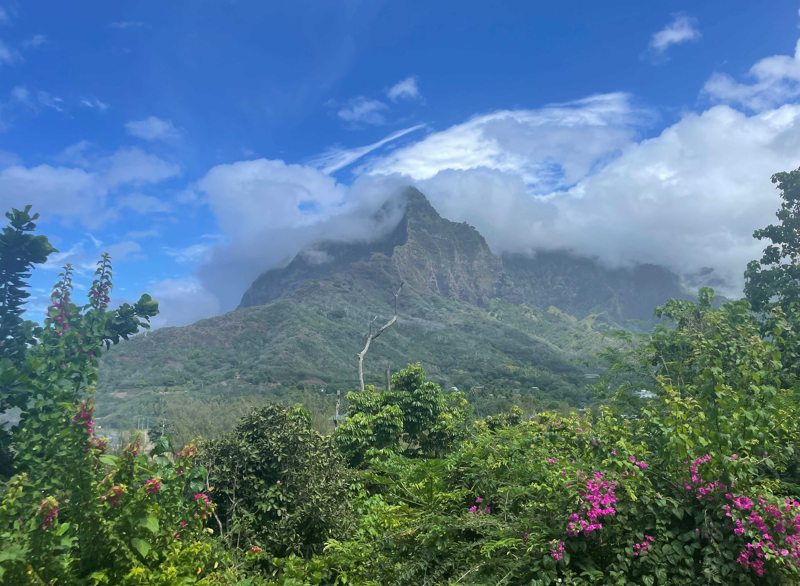
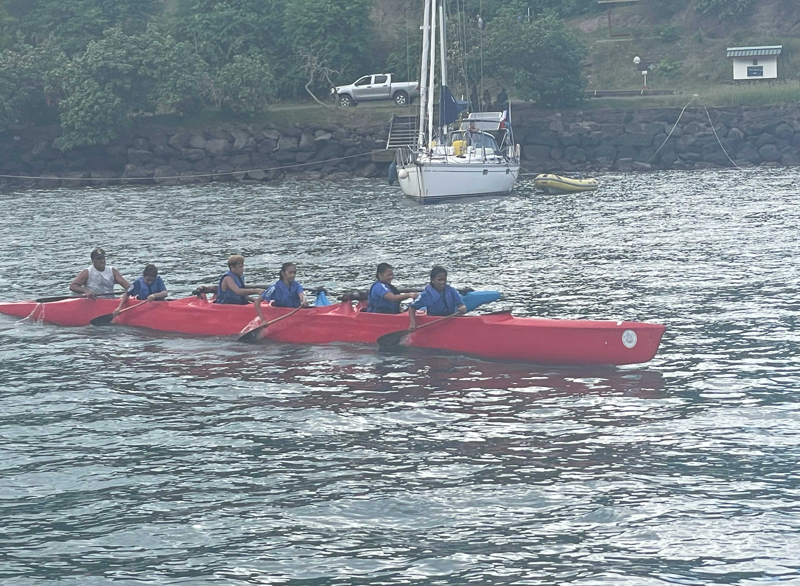
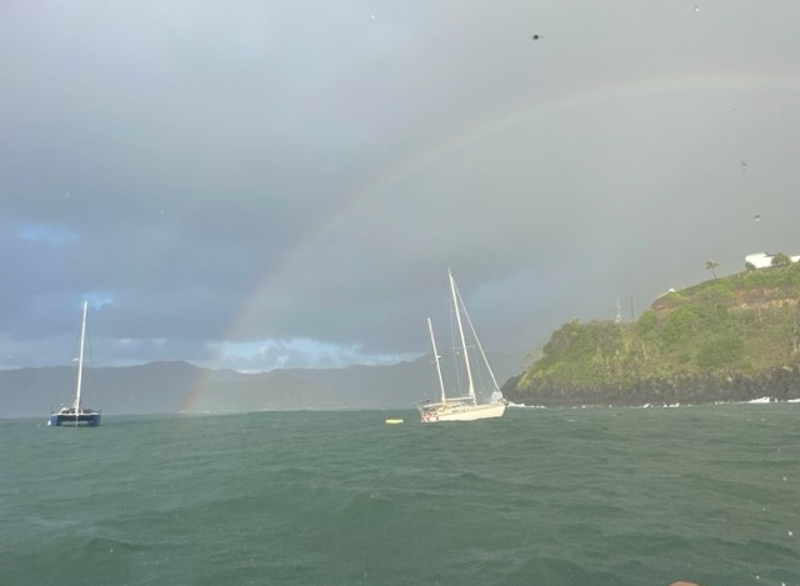
groceries, SIM cards, ATM, lunch and WIFI again. If you are lucky you can hitch a ride – or enjoy the walk. Fuel here was also limited – we were allowed 25 gallons per day – again, with dinghying jerry jugs. We got 2 days of fuel & go in early (7AM) on day 3 for another 25 before leaving for our next island. Sorry. We’re out! ARGH!
On to FATU HIVA, arriving in a curtain of rain hiding the Baie des Vierges (Bay of Virgins). OMG. What a surreal anchorage - known for its beautiful sunsets, black rocky beach with rocky spires and huge black pillars. With its heavy rainfall and lush vegetation, FATU HIVA is known to be one of the most dramatically beautiful islands in French Polynesia.
This is the only island still making tapas, cloth made from the bark of mostly mulberry, breadfruit or banyan trees with various geometric tattoo-style designs. We find Lucienne to drive us from Hanavave
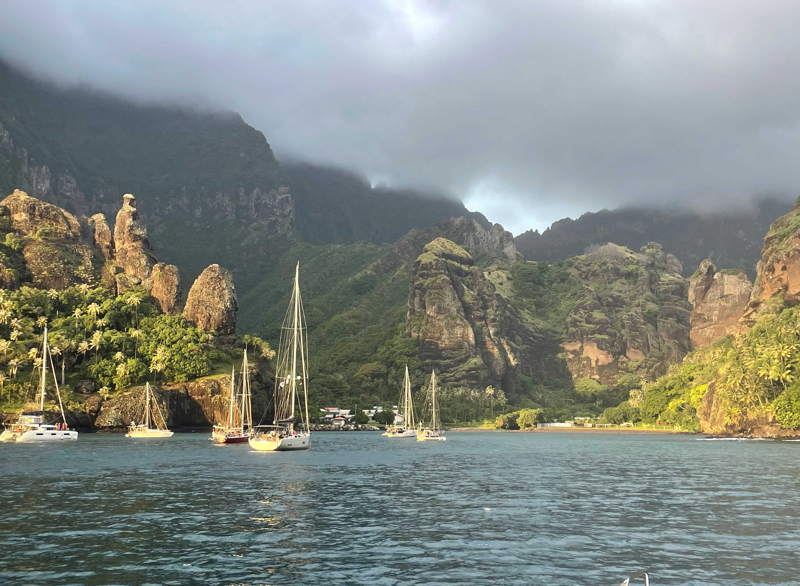
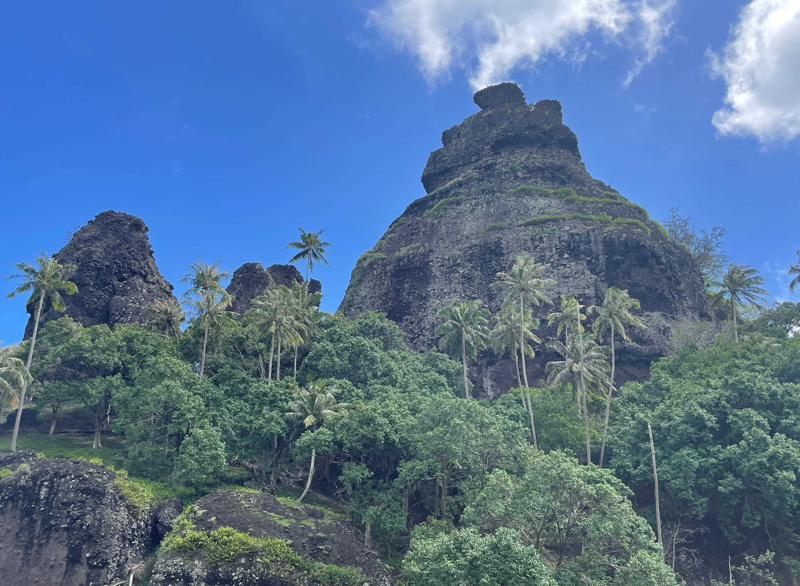
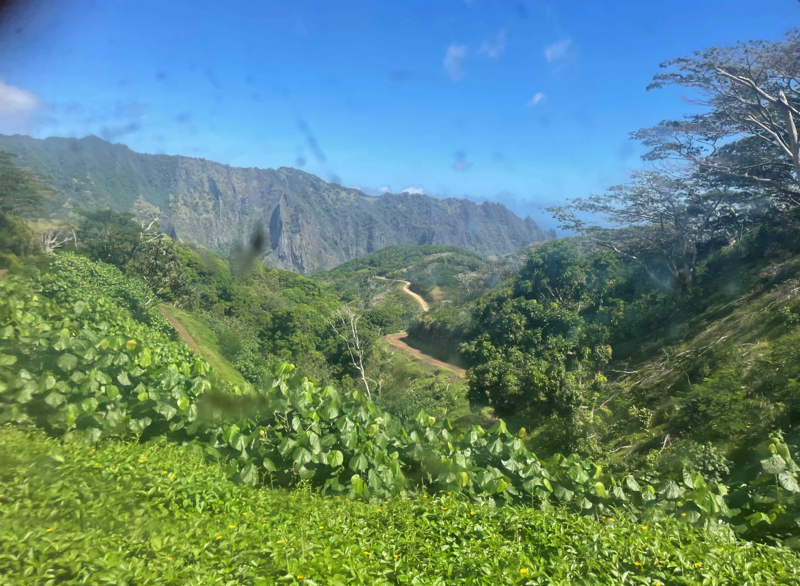
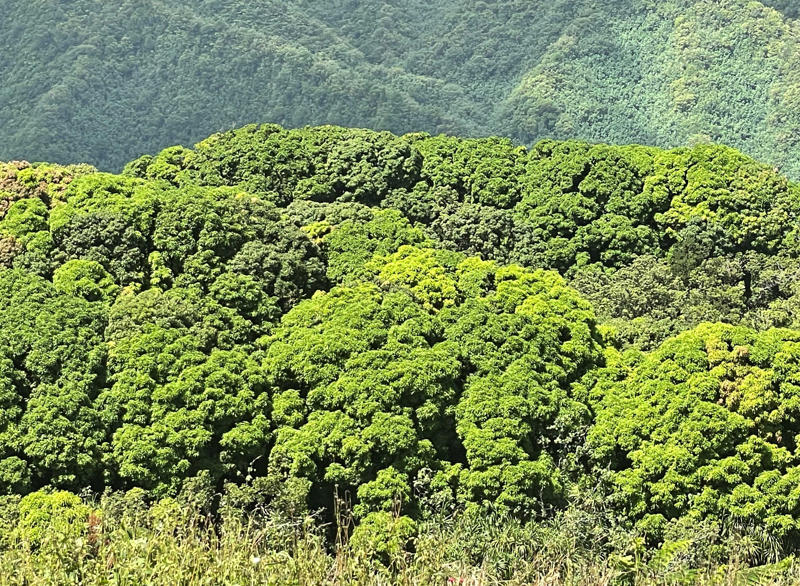
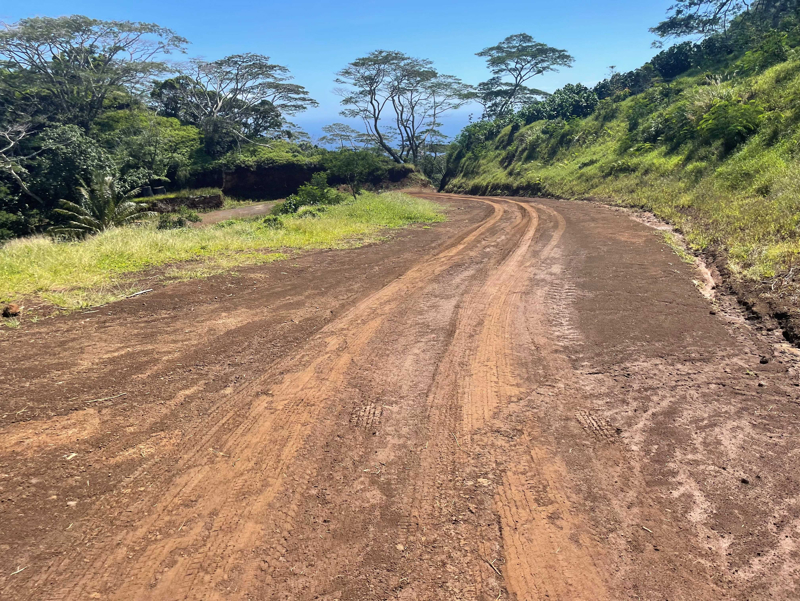
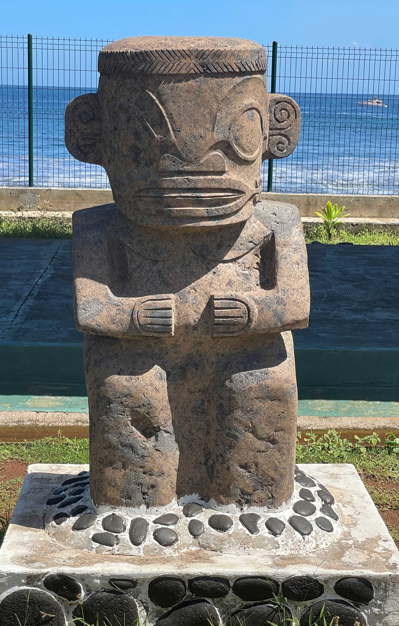
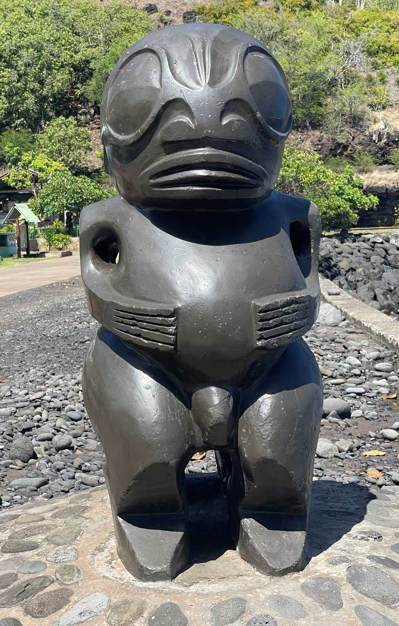



(the small village by the harbor) across the mountains to Omoa. Eleven miles of steep mostly slippery, muddy road scaling the mountains with switchbacks so tight you need to back up to make the turn – all with beautiful views looking straight down into the bays, valleys that look like over grown heads of broccoli, and a spectacular 200’ waterfall. Omoa, the only other and slightly larger village on FATU HIVA, is also on a bay. We could have gone by boat. But, the roller coaster ride was much more fun!
Sunday morning, 5/7, it's time to leave the Marquesas and head to the Tuamotus. Hoping for good winds for lots of sailing to preserve our limited fuel. (There was, of course, no place to refuel at Fatu Hiva.) Alas, what we hoped would be a 3 day sail ended up with lots of lights winds and motoring. We did find some winds tho - went from 5 knots to 50 knots in less than 5 minutes! (1 knot = 1.2 mph) YIKES! and it stayed over 35 knots for over an hour before it settled down. This is known in the sailing and meteorolgy world as a Squash Zone. Plus, less that 24 hours later, as we were waiting for the sun to rise and tides and current to be just right to enter the pass to enter the atoll, another sudden 35 knot wind came up.
Keep Calm
& Carry On,
XO XO
Gma & Gpa
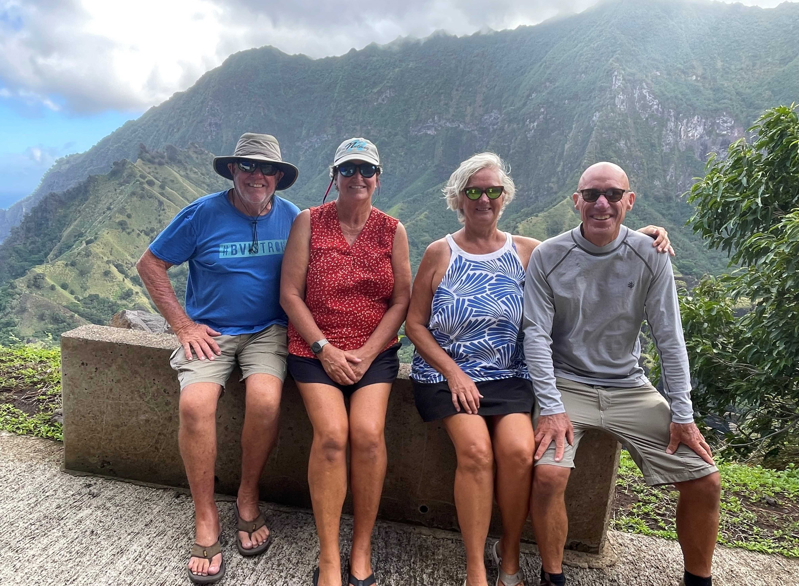
1.
Countdown
2.
...and We're OFF!
3.
...and waiting.
4.
Sailing Away!
5.
The San Blas
6.
Panama
7.
The Panama Canal
8.
The Transit
9.
Panama City
10.
27 Days at Sea
11.
The Marquesas
12.
Tuamotu Archipelago
13.
Moorea
14.
Tahiti
15.
On Vacation
16.
Raiatea
17.
Taha'a
18.
Huahine
19.
More Moorea
20.
Tahiti 2
21.
Sail On, Sailor
22.
Rarotonga
23.
Niue
24.
Vava'u
25.
Savusavu, Vanua Levu
26.
Yasawa Islands
27.
Viti Levu
28.
Viani Bay
29.
Taveuni Island
30.
Fiji Time
31.
Cyclone Season
32.
New Zealand
Share your travel adventures like this!
Create your own travel blog in one step
Share with friends and family to follow your journey
Easy set up, no technical knowledge needed and unlimited storage!
© 2025 Travel Diaries. All rights reserved.